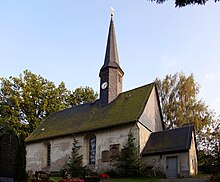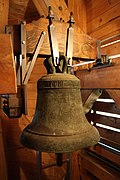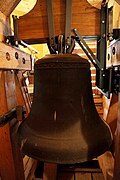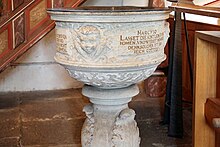Wallroda village church
The Wallroda village church is located in the Wallroda district of the municipality of Arnsdorf in Saxony . The church , the quarry stone wall of the old cemetery and two memorials are under monument protection.
history
In the middle of the 14th century, a village church in Wallroda was first mentioned in a church directory. There are no reliable records of the building and development of the church. It is uncertain whether the first-mentioned church already stood on the site of today's church. Some sources report that the first church was located on the right bank of the Großer Röder near the Schafberg . Wallroda's first houses were on the left bank of the river. Regular flooding repeatedly meant that people could not reach the church. For this reason, a new church was built on the other side of the Große Röder, the current location.
The church was a place of pilgrimage until the Reformation . Historical features of the village church are the two bronze bells, which date from 1410 and 1420, as well as a small measuring bell from the Catholic period of the church, which is dated to the beginning of the 16th century and thus to the pre-Reformation era. The construction time of today's church building is classified in the 17th century. The building has a simple, rectangular floor plan with an attached small vestibule. The roof has a steep classic saddle shape , the belfry and the clock tower are in an octagonal bell tower with pointed, slender spire housed. On the top of the tower roof is a gold-colored tower ball with a weather vane .
Peal
The bell consists of two bronze bells, the bell cage is made of oak. Below is a data overview of the bell:
| No. | Casting date | Caster | diameter | Dimensions | Chime |
|---|---|---|---|---|---|
| 1 | 14th century | Bell foundry unknown | 780 mm | 282 kg | c´´ |
| 2 | 15th century | Bell foundry unknown | 510 mm | 88 kg | G |
The large bronze bell is decorated with upside-down letters on the neck. They result in the sentence: "+ o.rex.glorie.veni cum.pace. +". The small bronze bell is decorated with Gothic minuscules on the neck. They result in the sentence: "o + rex + glorie + veni + cum + pace". It has an unrecognizable mark on the bolt, perhaps an imprint of a coin or a foundry mark.
inner space
The wooden winged altar and the wooden pulpit define the interior of the church. The baptismal font is in front of the altar . The baptismal jug dates from 1895. An engraving on the bottom of the jug lists the names of the Wallrodas families who donated this vessel to the church. The church pews , the galleries and the ceiling paneling are simple woodwork.
Baptismal font
The sandstone baptismal font was built around 1650 in the Renaissance style with the financial support of the parish. It is about one meter high and about 74 centimeters in diameter. The base of the baptismal font is decorated with three acanthus ornaments . The rim of the pool is decorated with reliefs of children's heads. In between there are quotes from the New Testament :
"Matthe 28 / Go and learn all / Volcker and teuffet them in / Name of the Father and / Sons and the Holy Spirit"
"Marcy 10 / Let the little children / come to me, and they do not / for such is the / Kingdom of God"
“Johan. 3 / Unless someone is born / is of the water and / holy spirit, he cannot / come into the kingdom of God "
altar
The winged altar of the church dates from the early 16th century (around 1520) and is assigned to the late Gothic . A comprehensive renovation took place in 1885. It consists of the middle altar shrine with two side wings and is approximately 1.45 meters high and over 2.10 meters wide with the wings open. The altar stands on a 50 centimeter high and 2.15 meter wide pedestal, the so-called predella . The inside and outside of the wings are decorated with paintings based on tempera paints . The outer sides show the Archangel Gabriel and Mary during the proclamation of the birth of Jesus Christ. The insides of the wings each show two pictures. The left side shows Paul of Tarsus before and after his conversion to Christianity, the two right paintings show the apostle Peter . In the central shrine there are three carved and colored painted figures: Mary with the baby Jesus in the middle, flanked by Paul and Peter. The painting on the predella depicts Christ with his twelve apostles .
pulpit
The pulpit of the church is dated to the 20s of the 17th century and thus to the Baroque era . During renovation work in 1902, an inscribed board was discovered inside the parapet that describes the completion of the pulpit in 1625. It stands on an octagonal column and is completely decorated with colored, wooden relief images. The pulpit hood has not been preserved, at the beginning of the 20th century only its entablature was preserved. The portraits in the panels of the parapet of the pulpit show the four evangelists Matthew, Mark, Luke and John. Between the pictures of the evangelists there are female, pillar-like sculptures, so-called herms . The frieze at the top of the pulpit bears the inscription:
“But these signs / by faith / are written / the life that you believe Jesus / his name / be Christ the son. / Johan. 20. "
Four relief images can be found at the entrance to the pulpit. These represent the three Christian virtues of faith , love and hope , which are supplemented by the virtue of patience as a fourth relief. The female figures in these images, which are unusually open-hearted for a church, are based on a representation of Demeter , the Greek goddess of fertility, agriculture and harvest.
Silbermann organ
From 1865 to 1902 there was a positive organ from the organ builder Gottfried Silbermann in the Wallrodaer church. The instrument was built in 1732/33 and from 1734 was initially in the old village church in Etzdorf . In 1865 the construction of a new church began in Etzdorf. The organ was sold to the Wallroda community. In 1902 the Wallroda church got a new organ from the organ builder Eduard Berger. Three registers from the Silbermann organ were used for the new organ. The Silbermann instrument was traded in by Berger, first came to Bischofswerda and, in 1919, privately owned to Dresden .
The cathedral cantor Richard Liesche and the organist Käte van Tricht discovered the organ in Dresden in 1939 and brought it to the Bremen cathedral . It is located in the west crypt of the cathedral. The organ registers remaining in Wallroda were brought to Bremen in 1993 by the Wallrodaer Kirchgemeinde and the Evangelical Lutheran Church of Saxony . In 1994 the organ was extensively restored. A board on the organ provides information about its history and its former location in Wallroda.
Memorial stones
First World War
In the north wall of the church there are three stone plaques. These commemorate the fallen soldiers of the place during the First World War . The middle, large panel shows a mounted soldier on his horse. The inscription on the tablet reads:
AND WHO FOUND DEATH IN THE HOT BATTLE
REST ALSO IN FOREIGN EARTH IN THE FATHERLAND
On the side, smaller panels, 28 Wallroda victims of the war are listed by name.
Second World War
On the eastern side of the cemetery wall there is a memorial stone for three victims of the Second World War . The unknown Soviet prisoners were murdered and buried in April 1945 on a death march from the Sachsenwerk Licht und Kraft AG labor education camp on the highway not far from the church. In October 1945 they were exhumed and buried in the village cemetery. The inscription on the stone reads:
THE DEAD REMEMBER
Three strangers
Resistance fighters
in April 1945
on the country road
slain by fascists.
The memorial was a pioneering object during the GDR era and was maintained by the lower grades of POS Kurt Schlosser Arnsdorf.
Redevelopment
In the 1990s and 2000s, the roof structure and the roof were renovated, as well as the mechanics of the bell tower after a lightning strike caused major damage. The organ was also extensively serviced in the 1990s.
Others
The Wallroda cemetery surrounding the church is divided into an old (north side) and a new (south side of the church) section. The parsonage right next to the church, consisting of a house and two barns, is also a listed building.
In the Evangelical Lutheran Church, services, weddings, christenings and funeral ceremonies are held regularly. The church choir rehearses both in the rectory and in the church. Every year on Christmas Eve the nativity play is performed with children and young people from the village.
Web links
- Wallroda in the net - information page of the youth club Wallroda eV with illustrated local history
- Churches in Arnsdorf on the homepage of the municipality of Arnsdorf
literature
- Cornelius Gurlitt : Descriptive representation of the older architectural and art monuments of the Kingdom of Saxony . With the participation of the K. Sächsischen Alterthumsverein. Ed .: K. Saxon Ministry of the Interior. 26. Issue: Amtshauptmannschaft Dresden-Neustadt (Land). CC Meinhold and Sons , Dresden 1904 ( digitized version ).
- Dresdner Heide, Pillnitz, Radeberger Land (= values of our homeland . Volume 27). 1st edition. Akademie Verlag, Berlin 1976.
- Rainer Thümmel: Bells in Saxony. Sound between heaven and earth. Edited by the Evangelical Regional Church Office of Saxony . With a foreword by Jochen Bohl and photographs by Klaus-Peter Meißner. Evangelische Verlagsanstalt, Leipzig 2011, ISBN 978-3-374-02871-9 ,
Individual evidence
- ↑ a b List of cultural monuments of the municipality of Arnsdorf, viewed on July 10, 2012.
- ↑ Woywod, Herbrecht (Ed.): Festschrift on the occasion of the 650th anniversary of Wallroda , Wallroda 2000.
- ↑ a b c d e f Cornelius Gurlitt : Descriptive representation of the older architectural and art monuments of the Kingdom of Saxony. 26. Issue: Amtshauptmannschaft Dresden-Neustadt (Land). Dresden 1904, p. 278 ff.
- ^ Rainer Thümmel: Bells in Saxony. Evangelische Verlagsanstalt Leipzig, ISBN 978-3-374-02871-9 , p. 367.
- ↑ Silbermann organ on the homepage of St. Petri Dom Bremen. Retrieved August 7, 2014 .
- ^ Documentation Office for the Saxon Memorials Foundation. Retrieved August 7, 2014 .
- ↑ Report on the death march according to eyewitness accounts. Retrieved August 7, 2014 .
Coordinates: 51 ° 6 ′ 46.2 ″ N , 13 ° 57 ′ 19.5 ″ E






